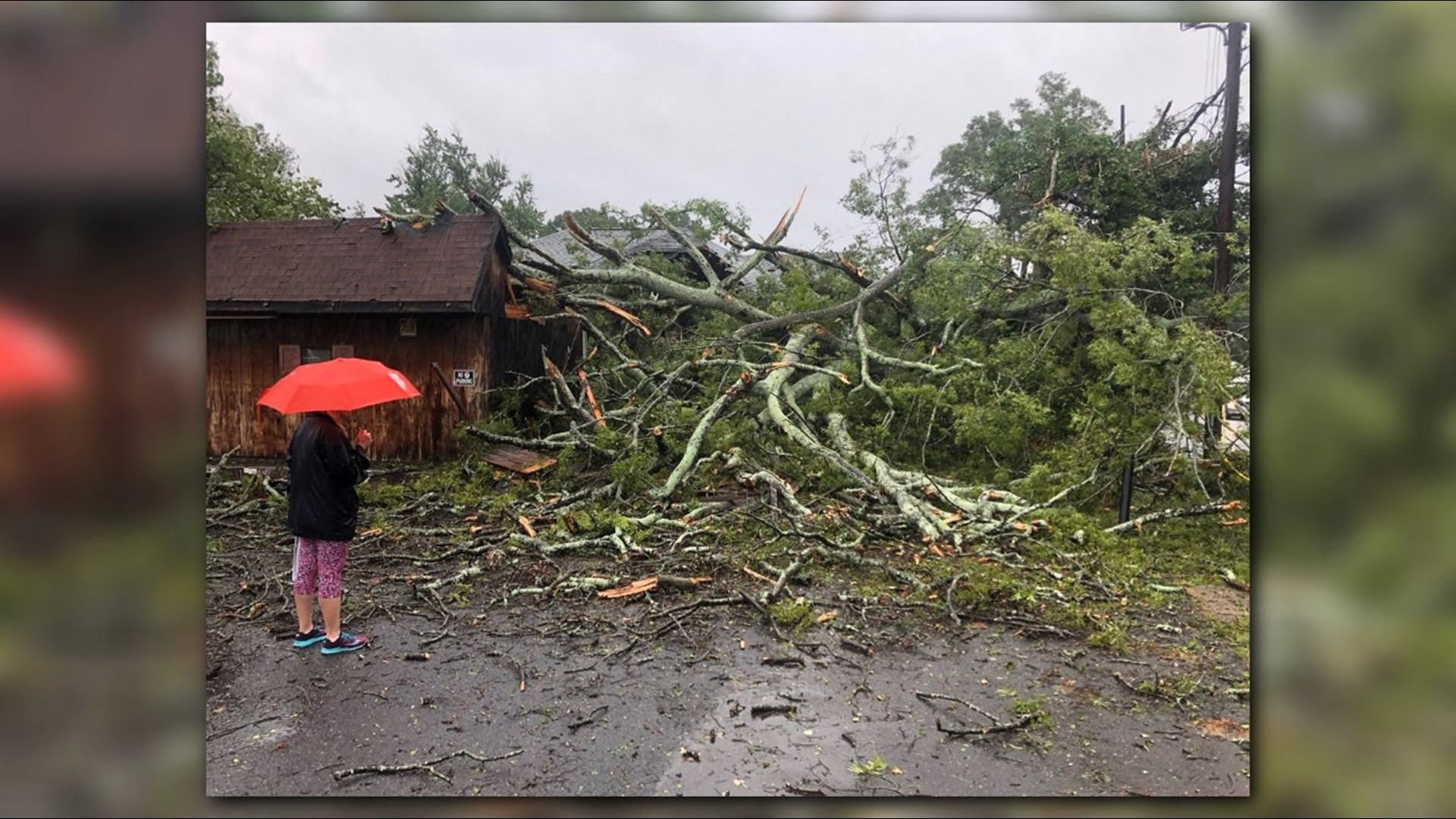Recognizing And Responding To A Flash Flood Emergency Situation

Table of Contents
Recognizing the Signs of an Impending Flash Flood
Understanding the potential for flash flooding in your area is the first step towards preparedness. Knowing the risk factors and how to identify visual warning signs can significantly increase your chances of survival. Heeding official warnings is equally critical.
Understanding Flash Flood Risk Factors
Several factors contribute to the risk of flash floods. Being aware of these factors allows for proactive measures.
- Heavy rainfall in a short period: Intense, localized downpours, especially in areas with poor drainage, can quickly overwhelm natural waterways and lead to rapid flooding.
- Overflowing rivers and streams: When rivers and streams exceed their capacity, water spills over their banks, causing widespread flooding in surrounding areas. This is a major flash flood indicator.
- Dam or levee failure: The failure of a dam or levee can release a massive amount of water in a very short time, resulting in catastrophic flash flooding downstream.
- Sudden release of water from a reservoir: Unexpected releases of water from reservoirs, often due to emergencies, can cause rapid and significant flooding downstream.
- Mountainous or hilly terrain: Steep slopes accelerate the flow of water, leading to rapid rises in water levels and increased flash flood risk. These areas are particularly vulnerable to flash flood events.
- Urban areas with poor drainage: Cities and towns with inadequate drainage systems are more prone to flash floods, as rainwater cannot be effectively absorbed or channeled away. Improperly maintained drainage infrastructure is a significant risk factor.
Geographical location plays a crucial role. Areas with a history of flash flooding, those near mountainous regions, or those with inadequate drainage systems are inherently at higher risk. Knowing your local flash flood history is vital.
Identifying Visual Warning Signs
Recognizing visual cues is paramount. Flash floods often develop rapidly, leaving little time for reaction.
- Rapidly rising water levels: A sudden and dramatic increase in water levels in rivers, streams, or normally dry areas is a major warning sign.
- Strong and swift currents: Fast-moving water indicates a significant flow, carrying debris and posing a serious threat.
- Debris flowing in the water: Logs, branches, and other debris carried by the water highlight the strength and speed of the current.
- Unusual sounds like roaring water: A loud, roaring sound from a normally quiet waterway indicates a rapid increase in water volume.
- Changes in water color: Muddy or discolored water can signify increased sediment and debris runoff, suggesting upstream flooding.
- Saturated ground unable to absorb more water: When the ground is completely soaked and unable to absorb any more water, runoff will increase dramatically, contributing to rapid flooding.
These visual indicators demand immediate action. Don’t wait for official confirmation; if you see any of these signs, prepare for a flash flood.
Heeding Official Warnings and Alerts
Staying informed is critical. Official warnings and alerts provide crucial information, allowing you to take appropriate action.
- Importance of subscribing to weather alerts (NOAA, local weather services): Sign up for weather alerts from reputable sources to receive timely warnings.
- Understanding different warning levels (watch vs. warning): A watch indicates conditions are favorable for flash flooding; a warning means flash flooding is imminent or occurring.
- Utilizing weather apps and websites: Many reliable weather apps provide real-time updates and flash flood alerts.
- Paying attention to local news and emergency broadcasts: Local news channels and emergency broadcast systems provide critical information during flash flood events.
Understanding the difference between a watch and a warning is vital. A watch means to be prepared, while a warning necessitates immediate action. Never underestimate official alerts.
Emergency Response Procedures During a Flash Flood
Responding swiftly and effectively to a flash flood is crucial for survival. Immediate action, seeking shelter, and post-flood safety precautions are all vital.
Immediate Actions to Take
Your immediate response will greatly impact your safety. Prioritize escape from harm's way.
- Move to higher ground immediately: This is the most important action; get to a safe, elevated location as quickly as possible.
- Avoid driving or walking through flooded areas: Never attempt to drive or walk through floodwaters; the depth and current are often deceivingly dangerous.
- Do not attempt to cross flowing water on foot or in a vehicle: The force of the water can sweep you away, even in seemingly shallow areas.
- Unplug electrical appliances: Protect yourself from electrocution by unplugging all appliances.
- Move valuables to higher floors: If time permits, move valuable items to higher floors or secure locations.
Floodwaters can hide deep holes and debris, creating significant hazards. Electrocution from downed power lines is a real threat. Prioritize your safety above all else.
Seeking Shelter and Evacuation
Knowing where to go and how to evacuate is vital. Planning ahead is crucial in these situations.
- Identify designated evacuation routes beforehand: Familiarize yourself with evacuation routes in your area before a flash flood occurs.
- Know the locations of emergency shelters: Locate nearby emergency shelters and understand how to access them.
- Follow instructions from emergency personnel: Always obey the instructions given by emergency services personnel.
- Communicate with family and friends: Establish a communication plan to ensure you can contact loved ones during and after a flash flood.
Preparing an emergency kit containing essential supplies like water, food, medication, and a first-aid kit is critical. Having a pre-established communication plan is also essential.
Post-Flood Safety Precautions
Even after the immediate danger passes, hazards remain. Post-flood safety is critical to long-term well-being.
- Avoid contact with floodwaters: Floodwaters are often contaminated with sewage, chemicals, and other hazardous materials.
- Check for structural damage to your home: Inspect your home for any damage and make necessary repairs to prevent further issues.
- Be aware of potential hazards like downed power lines: Avoid contact with downed power lines and report them to the authorities immediately.
- Report damage to authorities: Report any damage to your home or property to the appropriate authorities.
- Be aware of health risks related to contaminated water: Take precautions to avoid illness from contaminated floodwaters.
Floodwaters can contain harmful bacteria, viruses, and chemicals. Avoid contact and seek medical attention if you experience any symptoms.
Conclusion
Being prepared for a flash flood is essential for your safety and the safety of your community. By understanding the warning signs and implementing the necessary safety measures, you can significantly reduce your risk and protect yourself from the devastating effects of a flash flood. Remember to stay informed, heed official warnings, and develop an emergency plan. Don't wait – prepare for a flash flood today, and safeguard yourself and your family against this unpredictable natural disaster. Learn more about flash flood preparedness and safety by searching online for additional resources on "flash flood safety" and "flash flood preparedness."

Featured Posts
-
 Atletico Madrid Nasil Geriden Gelip Kazaniyor
May 25, 2025
Atletico Madrid Nasil Geriden Gelip Kazaniyor
May 25, 2025 -
 Euroleague Bathmologia Meta Ti Niki Tis Monako Epi Toy Parisioy
May 25, 2025
Euroleague Bathmologia Meta Ti Niki Tis Monako Epi Toy Parisioy
May 25, 2025 -
 How To Get Bbc Radio 1 Big Weekend 2025 Tickets Full Lineup Confirmed
May 25, 2025
How To Get Bbc Radio 1 Big Weekend 2025 Tickets Full Lineup Confirmed
May 25, 2025 -
 Trade War Fears Trigger 7 Plunge In Amsterdam Stock Market
May 25, 2025
Trade War Fears Trigger 7 Plunge In Amsterdam Stock Market
May 25, 2025 -
 55 Let Naomi Kempbell Smotrite Eksklyuzivnye Fotografii
May 25, 2025
55 Let Naomi Kempbell Smotrite Eksklyuzivnye Fotografii
May 25, 2025
Latest Posts
-
 Swiatek Wins In Madrid De Minaurs Tournament Ends In Straight Sets
May 25, 2025
Swiatek Wins In Madrid De Minaurs Tournament Ends In Straight Sets
May 25, 2025 -
 Madrid Open Update De Minaurs Early Exit And Swiateks Dominant Win
May 25, 2025
Madrid Open Update De Minaurs Early Exit And Swiateks Dominant Win
May 25, 2025 -
 De Minaur Out Of Madrid Open After Straight Sets Loss Swiatek Triumphs Over Keys
May 25, 2025
De Minaur Out Of Madrid Open After Straight Sets Loss Swiatek Triumphs Over Keys
May 25, 2025 -
 Alex De Minaurs Madrid Open Exit Straight Sets Defeat And Swiateks Victory
May 25, 2025
Alex De Minaurs Madrid Open Exit Straight Sets Defeat And Swiateks Victory
May 25, 2025 -
 Grand Slam Debut Alex Eala Set For Paris
May 25, 2025
Grand Slam Debut Alex Eala Set For Paris
May 25, 2025
